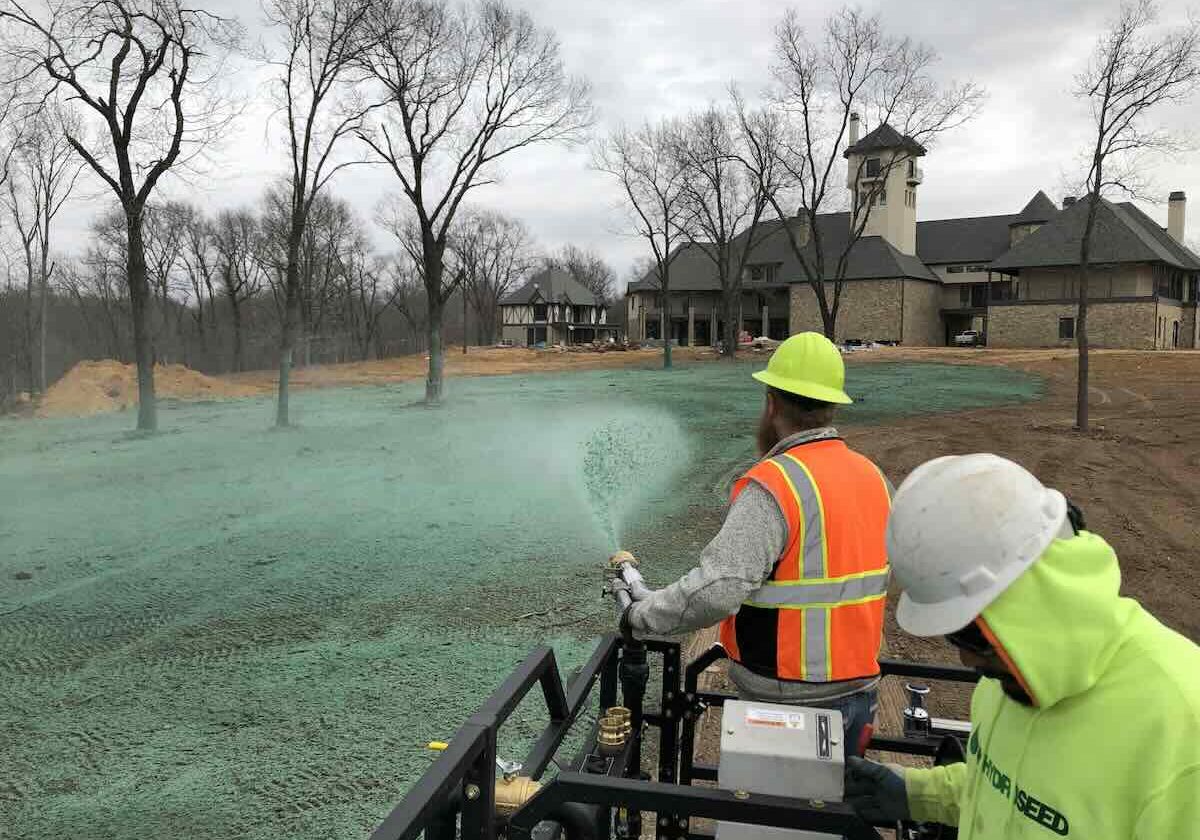7 Environmental Benefits of Hydroseeding

Share this article!
Hydroseeding is a broadcast planting method primarily used for planting grasses and vegetation, and can be modified to plant larger materials like small shrubs or crops. The hydroseeding process is called ‘hydroseeding’ because it involves mixing seeds in water, along with other ingredients, to create a thick slurry. Other ingredients in the hydroseeding mixture can include: fertilizer, tackifiers (soil stabilizers), soil amendments, mulch, and other additives.
Hydroseeding is especially effective for erosion control, soil stabilization, and landscaping projects. It’s commonly used on slopes, roadside embankments, and areas where traditional seeding methods might be costly, labor-intense, or ineffective.
Is Hydroseeding Environmentally Friendly?
Yes! Hydroseeding is generally considered environmentally friendly for three specific reasons:
1) Erosion Control: Hydroseeding can help prevent soil erosion and degradation which can negatively impact entire ecosystems. The hydroseeding process helps stabilize the soil, providing more hospitable environmental conditions for protective plants to establish and grow, which helps prevent runoff.
2) Environmentally-friendly Materials: Hydroseeding uses biodegradable materials like wood-fiber mulch and mulch blends which can support soil health as well as stabilization. Organic and environmentally-friendly fertilizers and additives can also be used to help support overall soil health and ecosystem sustainability and resiliency, while helping prevent harmful chemicals from entering the ecosystem.
3) Resource Efficiency: Compared with traditional planting methods like hand planting or broadcast seeding, hydroseeding generally uses less water, materials, and labor which helps reduce the overall environmental impact of planting.
Hydroseeding For Erosion Control
Protecting bare soil and any landscape that has been disturbed through agriculture or construction is key to minimizing the overall environmental impact of these activities. Hydroseeding provides a quick, effective method to control sediment runoff which can pollute waterways, while helping to control erosion in the targeted areas. As an erosion control technique, hydroseeding is one of the most beneficial and cost effective approaches to stabilizing soil, protecting the larger ecosystem, and providing a sustainable landscaping option.
Hydroseeding is an effective erosion control technique because it helps protect soil from the erosive forces of both wind and water. Due to its specialized application and customized slurry, hydroseeding helps establish grasses and other plants quickly, while encouraging robust root systems. These root systems provide physical protection at the soil’s surface, as well as underneath the soil where the extensive root systems create structural support.
Traditional seeding methods can take much longer to both apply, and to have an impact, as seeds planted this way tend to take longer to germinate and establish a wide root base.
Water Conservation With Hydroseeding
Wherever soil is disturbed, there’s a higher potential for uncontrolled runoff which can lead to both water pollution in the ecosystem and water waste. Using hydroseeding, both of these impacts can be reduced. Hydroseed slurry can be mixed to contain water-retaining and absorbing mulch which helps trap moisture near the soil rather than running off into surrounding waterways. In addition to helping absorb and trap water, the mixture of water and mulch helps accelerate seed germination and root growth.
Hydroseeding is an effective water conservation tool as well. Because mulches are so absorbent, water needs for the entire area are reduced, so less water overall can be used, and less frequently, to achieve even better results from planting.
Enhancing Soil Health with Hydroseeding
Another environmental benefit of hydroseeding is improved soil health. Because organic mulch and organic matter can be added to hydroseeding slurry, these soil amendments can be customized to match the specific needs of an area’s soil. For example, an area low in nitrogen or calcium can be supported with the inclusion of a nitrogen or calcium-rich fertilizer or soil amendments applied simultaneously with moisture and matter-retaining mulch.
The mulch improves soil quality by adding important nutrients and minerals back into the soil as the mulch slowly breaks down. Since soil conditions benefit so much from hydroseeding, it can be used effectively for areas in need of land rehabilitation.
Effective Weed Control without Chemicals
Another added benefit of hydroseeding is the natural suppression of weeds and their seeds. Because hydroseeding mixtures can be customized for specific seeds, and is often applied with mulch, it works in a two-pronged approach to suppress weed growth. The mulch prevents weed seeds from germinating, and the optimal conditions for desired seeds mean that the intended seeds can establish quickly and thrive before weeds have a chance to grow.
Suppressing weeds naturally with hydroseeding can also often eliminate the need to use herbicides and other harmful chemicals to control weeds, which can leach out into water ways and the larger ecosystem.
Promoting Biodiversity through Hydroseeding
Hydroseeding can play an important role in promoting biodiversity by facilitating the establishment of native plant species, particularly native grasses, in larger ecosystems. Hydroseeding can be used to introduce native seeds into areas where soil has been disturbed or degraded, making it an effective method to restore biodiversity and support the local habitat.
Planting this way also enhances the natural resiliency of the ecosystem by supporting the introduction of native plants that are already well adapted to the climate and conditions, so they require less water and maintenance while simultaneously providing crucial support for the other plant, insect, and animal life in the ecosystem.
Achieving Faster Germination and Vegetation Cover
Establishing seeds and plants quickly is an important step in protecting an area impacted by soil disruption. Seeding native plant species quickly not only supports the ecosystem, it also helps support the soil health by providing reliable root structure and reducing the time it takes for seed germination to take place.
The faster seeds germinate and establish, the faster beneficial root stabilizing structures can establish in the soil, and the faster vegetation can grow to provide added cover and support for the soil and the ecosystem.
The Cost-Effectiveness of Hydroseeding for Large Areas
Hydroseeding large areas, especially with native plant species, can provide an economical as well as efficient solution for disrupted or bare land. The cost savings associated with native plant species is especially compelling , as these generally require less maintenance and less water to establish and thrive in the environment.
In addition to the cost savings associated with maintenance, hydroseeding large areas is also typically more affordable than traditional methods of planting because application teams can be smaller, and get more done in less time.
Conclusion
From water conservation and weed control to soil health and enhanced biodiversity, when it comes to sustainable landscaping, hydroseeding is a sought-after solution for a variety of landscapes and projects in order to meet budget and environmental regulations.
For additional resources on how hydroseeding can be used to solve a variety of regulatory and compliance issues across industries, reach out to our team for sustainable landscaping solutions.
